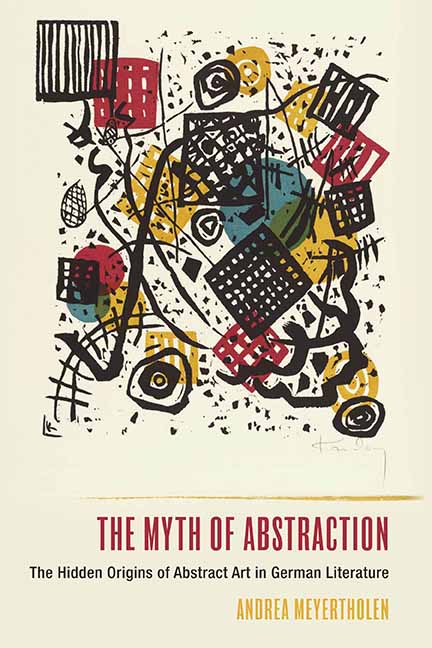Book contents
- Frontmatter
- Dedication
- Contents
- List of Illustrations
- Acknowledgments
- Introduction: The Many Origins of Abstract Art
- 1 Apocalypse Now: Heinrich Von Kleist’s Sublime Deframing of Caspar David Friedrich’s Der Mönch Am Meer (1810)
- 2 The Kleistian Sublime Is Now: Kazimir Malevich, Mark Rothko, Barnett Newman
- 3 The Clouding of Perception: Seeing The (Un)Real Potential for Abstraction in the Poetry and Science of Goethe’s Clouds (1821)
- 4 In the Service of Clouds or Optical Illusion?: Romanticism, Pointillism, and Impressionism
- 5 Driven to Distraction and from Abstraction: The Birth and Death of Abstract Art in Gottfried Keller’s Der Grüne Heinrich (1854/55, 1879/80)
- 6 Inside the Mind and Outside the Margins: The Unruly Lines of Paul Klee, André Masson, and Cy Twombly
- Epilogue: Laocoön and His Sisters: The Future of Literature and Art
- Bibliography
- Index
1 - Apocalypse Now: Heinrich Von Kleist’s Sublime Deframing of Caspar David Friedrich’s Der Mönch Am Meer (1810)
Published online by Cambridge University Press: 07 May 2022
- Frontmatter
- Dedication
- Contents
- List of Illustrations
- Acknowledgments
- Introduction: The Many Origins of Abstract Art
- 1 Apocalypse Now: Heinrich Von Kleist’s Sublime Deframing of Caspar David Friedrich’s Der Mönch Am Meer (1810)
- 2 The Kleistian Sublime Is Now: Kazimir Malevich, Mark Rothko, Barnett Newman
- 3 The Clouding of Perception: Seeing The (Un)Real Potential for Abstraction in the Poetry and Science of Goethe’s Clouds (1821)
- 4 In the Service of Clouds or Optical Illusion?: Romanticism, Pointillism, and Impressionism
- 5 Driven to Distraction and from Abstraction: The Birth and Death of Abstract Art in Gottfried Keller’s Der Grüne Heinrich (1854/55, 1879/80)
- 6 Inside the Mind and Outside the Margins: The Unruly Lines of Paul Klee, André Masson, and Cy Twombly
- Epilogue: Laocoön and His Sisters: The Future of Literature and Art
- Bibliography
- Index
Summary
ALL ART IS AN ABSTRACTION from reality, whether in cave paintings or in naturalist depictions of the perceptual world. However, not all art is an abstraction in service of reality. While some artworks encourage or provoke onlookers to reflect on this discrepancy, others tend to lead its observers to forget it. Some works of art even lead later observers to see its abstract moments where contemporaries did not, and vice versa. Thus, to ascribe “the” discovery or invention of abstract art to any specific artwork or artist would be irresponsible or at the very least problematic. Nevertheless, examining how onlookers of art have perceived its abstract moments remains quite fascinating and relevant not only to our understanding of art but to literature as well. Written documents by critics, connoisseurs, and philosophers form their own history, many histories even, of reflections about abstraction in art, each opening specific registers of abstraction. This chapter will feature one such written reflection and the distinct form of abstraction it engenders. The choice of this particular written reflection is neither arbitrary nor unfounded. Although it existed prior to Kandinsky, it augments one of the multiple lineages of abstraction in the visual arts that will lead to and beyond Kandinsky and his kin—namely, those artists who initially realized the promise of nineteenth-century literary imaginings of abstract art by physically creating abstract artworks in the twentieth century. Yet this unpainted birth moment of abstract art did arise from an artwork, one that, though still attempting to portray reality, did so in a manner so abstracted that it provoked the conceptual shift in a critical viewer. The artwork is Der Mönch am Meer (The Monk by the Sea) by Caspar David Friedrich (1774–1840); its critical viewer was Heinrich von Kleist (1777–1811).
This early imagining of abstract art finds expression through narrative form in the words of Kleist and his 1810 commentary “Empfindungen vor Friedrichs Seelandschaft” (“Sensations before Friedrich's Seascape”). Kleist's short piece is perhaps the most famous reaction to a controversial artwork that created a stir in its audacious flouting of tradition and convention.
- Type
- Chapter
- Information
- The Myth of AbstractionThe Hidden Origins of Abstract Art in German Literature, pp. 22 - 54Publisher: Boydell & BrewerPrint publication year: 2021



